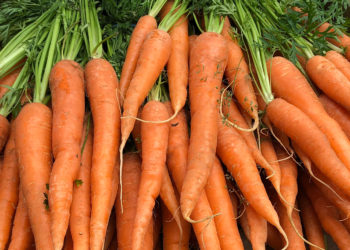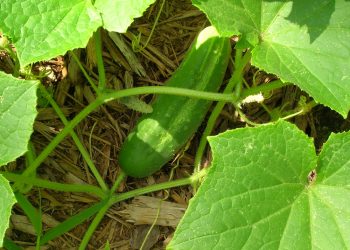If you are growing asparagus for the first time, then you probably have some questions about when to start harvesting and how to go about it. If you’ve forgotten everything your grandma taught you, or you were just too young to remember anything past that wonderful taste, we hope this will help.
The very first rule is patience! An asparagus bed, if established and maintained properly, can produce asparagus spears in excess of 15 years. In fact, some asparagus beds have been producing for 30 years! So, the first year you want to avoid harvesting, except maybe to get a very tiny taste of what’s to come, and concentrate on growing the healthiest and strongest root system possible.
The First Year
We recommend babying your asparagus through the first year. Invading perennial grasses are young asparagus’ worst enemy, so keep them under control as your young plants are becoming established. Depending upon where you are planting, you may want to install a barrier, keeping it in place through the first year, to be removed at a later time if you choose.or not. The root system of asparagus goes deep and becomes quite extensive, but the plants need that first full year to really take hold and to survive the winter, especially in the coldest regions. You should provide 1 to 2-inches of water per week during the first two years and feed well. After the second year, you can water more infrequently. You might want to use a soaker or drip hose through your asparagus bed, rather than watering from the top as this will allow the water to soak deeper, instead of settling on the tops of the plants; there will also be less evaporation, resulting in less water use. Applying mulch around your plants will also conserve water, as well as inhibiting weed and grass growth.
As the spears are left to grow past the point of harvesting, the tops will open up and become fern-like. They are actually quite pretty, but also a very important aspect to the continuing good health of your asparagus bed. Using photosynthesis, these ferny tops will send food throughout the spears and into the crowns below the surface, ensuring the perpetual harvest that this perennial vegetable provides.
When it comes to cutting back your asparagus plants, there are basically two schools of thought. Some gardeners cut them back to the ground once they turn brown, going dormant, usually after the first heavy frost. In fact, some people just mow them down as close to the soil as possible, either adding the foliage to their compost bin or discarding it. The other half of asparagus growers will leave the ferny tops to catch the snow and to protect and insulate the plants, while providing necessary moisture throughout the winter and into early spring. Cut them back in March or early to mid-April, depending upon your climatic zone. Besides helping your plants to survive the winter, the brown, feathery ferns will add a bit of winter-time interest to your stark garden landscape, especially when coated in layers of sparkling hoar frost.
 The Second Year
The Second Year
Finally, your patience has paid off! The spears are growing and you can start harvesting, but only for a little bit and only a little at a time. At no time should you harvest spears that are not at least as big around as your little finger. For this second harvest year, we suggest that you only harvest for the first 2 to 3 weeks. Heavy and continual harvesting past this point may weaken the plants, meaning that your asparagus bed will not continue to develop well for subsequent years. Just a little more patience is required. Time flies and a little patience now will reap huge rewards in three, four, five..fifteen or twenty years!
In most areas of the country, you will be able to start harvesting in May and continue into June. Asparagus is considered a cool weather crop and will be one of the first vegetables ready for harvest, even before your lettuce, broccoli and cauliflower. However, in more temperate climates, like that of southern California, you may have to treat your asparagus a bit differently, keeping track of the normal growing cycle for this perennial and allowing the ferny tops to grow and develop, rather than harvesting for an extended period just because you can. And then cut the plants back in late fall or early winter to encourage dormancy that occurs naturally in other climates.
As in all things gardening, gardeners have different ideas on what is the best way to harvest. Some prefer to use their thumb and forefinger to snap the spear at ground level, while others will use a sharp knife or asparagus harvesting tool to cut the spear one or two inches below the soil. It is our belief that use an asparagus knife to cut below the soil allows the plant and crown to be protected by that layer of soil, from both the hotter summer temperatures and marauding pests. A clean, sharp tool will also ensure that the plants are not stressed from the cutting. Pulling and tugging while snapping the spear can result in damage to the crown below the spear, which is already developing new buds for next year’s harvest.
Don’t forget! Only harvest this second year for 2 to 3 weeks! Your patience will be well-rewarded.
The Third Year and Into the Future
Now that your asparagus bed is well-established, you can harvest spears that are emerging which are 3/8 or larger (about the size of one’s little finger). Also, don’t submit to the myth that the larger the diameter of the spear, the less tender they are. That is just not the case at all. What IS true, is that as the season progresses, the part of the spear below the ground and possibly 1 or 2-inches up, may become somewhat tougher. This is just a fact of life when it comes to asparagus and one easily remedied by just cutting off the tougher part. You will still have plenty of tender asparagus spear above this point. If you’ve missed harvesting some spears and the tips are no longer tight and closed, you will be a little disappointed in the quality, so allow those spears to open and become ferny. You won’t be wasting them, just allowing them to become next year’s harvest.
 As a rule, you will harvest every other day when the spears are between 4 and 8-inches tall and usually for a period between 6 and 8 weeks, depending upon your geographical location, and also depending upon the weather for that particular year. Hotter weather will shorten your harvesting season, while cooler weather will extend it.
As a rule, you will harvest every other day when the spears are between 4 and 8-inches tall and usually for a period between 6 and 8 weeks, depending upon your geographical location, and also depending upon the weather for that particular year. Hotter weather will shorten your harvesting season, while cooler weather will extend it.
Again, once you notice that the emerging spears are smaller than your little finger, quit harvesting and allow the ferny tops to develop, effectively perpetuating the cycle that will have your grandchildren and great-grandchildren harvesting the asparagus bed you plant today. Early summer mornings, working by grandma’s or grandpa’s side, will be a perennial memory!





11 Comments
Mary
August 22, 2012 at 10:19 amI live in Tampa, Florida. My first crop of asparagus is beautiful! The bed of ferns are full, green and about 4 feet tall. In my climate, when should I cut back the ferns? Thanks
jstutzman
August 22, 2012 at 11:14 amDo you you get frost or freezing temperatures where you are at?
TJ
March 18, 2013 at 5:21 pmVery nice article. Thanks for the info!
Chris
May 5, 2014 at 3:49 pmI live in Montrose, Colorado where wild asparagus grows in many places near irrigation ditches. I notice that many harvesters snap the spears off mid length, leaving several inches sticking out of the ground. Is this harmful to the plant? Is it important to cut the spear at the ground and trim the woody bits at home or just snap off the good parts and leave the rest?
jstutzman
May 6, 2014 at 9:02 amChris, if the spears are snapped off that far above the ground they will start to fern faster, giving you less asparagus that is able to be harvested. As the asparagus spears become “woody”, you will naturally get less of the spear that is able to be used each time you harvest. Cutting them back to the ground allows the spear to be harvested for a longer period of time. If you only snap them off above the “woody” part of the spear, you will soon run out of spears to harvest. Good luck with our asparagus!
Lover of Asparagus
May 23, 2015 at 5:24 pmI have planted seeds in with my crowns that were planted in 2012. I just harvested for over two weeks. My first question is will it take longer for the seedlings to mature like 4 years? Not like 2 if I planted the crowns (Mary Washington, ready in 2 years) and can you tell the difference with a male and a female seedling. I want to pull the females before they get any bigger. All my crowns are male. Great article by the way, very informative. Thank You.
jstutzman
May 27, 2015 at 3:37 pmHello Lover of Asparagus. Yes it will take them longer as they have a lot of roots to develop. The same rule applies, do not harvest any spear until it is as thick as your little finger. Good Luck!
Jonica Bradley
June 12, 2016 at 1:55 pmMy husband brought home so.e asparagus root balls from a patch that has been growing at least 15 years which itself was transplanted from somewhere else.
We have at least one spear already sprouting.
My question: do you consider this a first year asparagus? How should we harvest?
jstutzman
June 16, 2016 at 8:20 amJonica, you should treat this as a first year asparagus. Since it was transplanted, there will not be enough roots in the new location to allow any harvesting of the spears. You should be able to harvest next season. Happy gardening. Joe
Lidia
December 11, 2016 at 9:17 pmHi, I live in Southern California. I planted asparagus from root approx 1 year ago and now the plants are tall ferns. They recently began turning yellow. Should I trim them down or allow to continue as they are? They are planted in a raised garden bed. Thank you.
jstutzman
January 3, 2017 at 12:02 pmLidia, Yes you can go ahead and cut the asparagus ferns back to the ground level. You are welcome. Joe